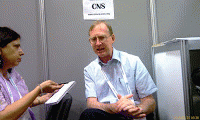Watch the video interview with Dr Anthony Harries here: https://www.youtube.com/watch?v=PF9bILRWv1c

Dr Anthony D Harries, Director, Department of Research, The Union
(Image by Citizen News Service (CNS)) Details DMCA
(CNS): There are over 1 million new TB cases in people living with HIV (PLHIV) and 320,000 HIV/TB deaths every year. Moreover HIV increases the risk of getting TB manifold - PLHIV have an annual 5%-15% risk of acquiring TB infection as against is 5%-15% lifetime risk in HIV-negative persons. Challenges to concurrent HIV and TB therapy - like pill burden, overlapping drug toxicities, pharmacokinetics of drug-drug interactions, increased risk of immune-restoration disease - have led to debates on when to initiate ART in patients with newly diagnosed HIV infection and TB. However, results of a few important studies produce strong evidence to improve treatment outcomes for PLHIV as well as to protect them from co-infections like TB.
The START (Strategic Timing of AntiRetroviral Treatment) study assessed whether early initiation of antiretroviral therapy (ART), at CD4+ T-cell counts above 500 cells/mm3, would lead to a lower risk of AIDS or other serious health issues compared to waiting until a patient's CD4 count fell to 350 cells/mm3. The results showed that the risk of serious AIDS-related illness, serious non-AIDS-related illness and death, was reduced by 53% (more than half) among those in the early treatment group compared to those in the deferred-treatment group. The most common AIDS-related illnesses among study participants were pulmonary TB, Kaposi's sarcoma, and non-Hodgkins lymphoma.
The TEMPRANO study assessed the efficacy of early ART in reducing the rate of severe illness among HIV-infected adults along with assessing the benefit of combining isoniazid-preventive therapy (IPT) with early ART. It was seen that 6 months of IPT combined with early ART, before the CD4+ count reaches 500 cells/mm3, led to improved outcomes and that the spectrum of diseases for which early ART has a protective effect includes not only TB but also invasive bacterial diseases. Study data suggest that in low-resource settings, ART provides substantial clinical benefits in patients who have higher CD4+ counts at the time of initiation than those previously recommended for the initiation of ART.
Another study, Early HIV Treatment Improves Survival in Some Patients with Newly Diagnosed TB, evaluated early versus delayed ART initiation (1 to 4 weeks vs. 8 to 12 weeks after initiation of TB treatment) or deferred ART initiation (after the end of TB treatment). It was found that starting ART within two weeks of the diagnosis of TB improved survival among patients with both infections who had very low CD4 T-cell counts
[Watch CNS Video featuring interview with Dr Anthony D Harries]
During an interview given to Citizen News Service (CNS) at the recently concluded 5th Asia Pacific Region Conference on Lung Health, Dr Anthony Harries, Director, Department of Research, at International Union Against Tuberculosis and Lung Disease (The Union), mentioned that apart from TEMPRANO, another study also shows that adding 12 months of isoniazid preventive therapy (IPT) to ART gave the added benefit of significantly reducing the incidence of all TB diagnoses in PLHIV. While presenting her findings at AIDS 2012, Dr Molebogeng Rangaka of the University of Cape Town had said, "There was a 37% reduction in the rate of incident TB in the IPT treatment group compared to those who were receiving ART alone. There is a suggestion, although not significant, that the effect of IPT seems to wane by duration. But that effect did not wane as rapidly as in patients not on ART, with the effect seeming stable for about a year."
Dr Harries told CNS that, "We have known for long that ART provides good protection to PLHIV from TB also. We also know that at low CD4+T cells count, immunity is suppressed and ART brings that immunity up, providing protection against infections like TB. Data from several studies (mentioned above) provides evidence that if ART is started as soon as one is diagnosed with HIV (irrespective of CD4+T cells count) it prevents from developing AIDS, and protects from getting TB (even though this protection is not 100%).
(Note: You can view every article as one long page if you sign up as an Advocate Member, or higher).





